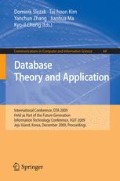Abstract
Full implementation of the Semantic Web requires widespread availability of OWL ontologies. Manual ontology development using current OWL-aware editors remains a tedious and cumbersome task that can easily result in a knowledge acquisition bottleneck. Conceptual schemata such as UML class diagrams, on the other hand, capture abundant domain knowledge. Thus developing approaches and tools for extracting the available knowledge can facilitate the development of OWL ontologies and the construction of various Semantic Web applications. In this paper, a formal approach for extracting OWL DL ontologies from existing UML class diagrams is presented. The approach establishes a precise conceptual correspondence between the two models and relies on a semantics-preserving UML-to-OWL translation algorithm. Tool implementation and case study show that the proposed approach is effective and fully automatic ontology extraction from UML Class Diagrams is implementable.
Access this chapter
Tax calculation will be finalised at checkout
Purchases are for personal use only
Preview
Unable to display preview. Download preview PDF.
References
Berners-Lee, T., Hendler, J., Lassila, O.: The Semantic Web. Scientific American 284(5), 34–43 (2001)
Jacob, E.K.: Ontologies and the Semantic Web. Bulletin of the American Society for Information Science and Technology 29(4), 19–22 (2003)
Dean, M., Schreiber, G. (eds.): OWL Web Ontology Language Reference. W3C Recommendation (2004), http://www.w3.org/TR/owl-ref/
Maedche, A., Staab, S.: Ontology learning for the Semantic Web. IEEE Intelligent Systems 16(2), 72–79 (2001)
Object Management Group: Unified Modeling Language: Superstructure, Version 2.0 (2005), http://www.omg.org/docs/formal/05-07-04.pdf
Volz, R., Handschuh, S., Staab, S., et al.: Unveiling the hidden bride: deep annotation for mapping and migrating legacy data to the Semantic Web. Journal of Web Semantics 1(2), 187–206 (2004)
Stollberg, M., Lausen, H., Lara, R., et al.: Towards Semantic Web portals. In: Proc. of the WWW 2004 Workshop on Application Design, Development and Implementation Issues in the Semantic Web, CEUR Workshop Proceedings, vol. 105 (2004), http://CEUR-WS.org/Vol-105/
He, B., Patel, M., Zhang, Z., Chang, K.C.-C.: Accessing the Deep Web. Communications of the ACM 50(5), 94–101 (2007)
Sahoo, S.S., Halb, W., Hellmann, S., et al.: A Survey of Current Approaches for Mapping of Relational Databases to RDF. In: W3C RDB2RDF Incubator Group report (2009), http://www.w3.org/2005/Incubator/urw3/XGR-RDB2RDF-20090108/
Cranefield, S.: UML and the Semantic Web. In: Proc. of the first Semantic Web Working Symposium, pp. 113–130. Stanford University, California (2001)
Baclawski, K., Kokar, M.K., Kogut, P.A., et al.: Extending UML to support ontology engineering for the Semantic Web. In: Gogolla, M., Kobryn, C. (eds.) UML 2001. LNCS, vol. 2185, pp. 342–360. Springer, Heidelberg (2001)
Djuric, D., Gasevic, D., Devedzic, V.: Ontology modeling and MDA. Journal of Object Technology 4(1), 109–128 (2005)
Gasevic, D., Djuric, D., Devedzic, V.: MDA-based Automatic OWL Ontology Development. International Journal on Software Tools for Technology Transfer 9(2), 103–117 (2007)
Falkovych, K., Sabou, M., Stuckenschmidt, H.: UML for the Semantic Web: transformation-based approaches. In: Knowledge Transformation for the Semantic Web, Frontiers in Artificial Intelligence and Applications, vol. 95, pp. 92–106. IOS Press, Amsterdam (2003)
Na, H.-S., Choi, O.-H., Lim, J.-E.: A method for building domain ontologies based on the transformation of UML models. In: Proc. of 4th Int’l Conf. on Software Engineering Research, Management and Applications, pp. 332–338. IEEE Computer Society, Los Alamitos (2006)
Berardi, D., Calvanese, D., Giacomo, G.D.: Reasoning on UML class diagrams. Artificial Intelligence 168(1-2), 70–118 (2005)
Calvanese, D., Lenzerini, M., Nardi, D.: Unifying class-based representation formalisms. Journal of Artificial Intelligence Research 11, 199–240 (1999)
Patel-Schneider, P.F., Hayes, P., Horrocks, I. (eds.): OWL Web Ontology Language Semantics and Abstract Syntax. W3C Recommendation (2004), http://www.w3.org/TR/owl-absyn/
Horrocks, I., Patel-Schneider, P.F., van Harmelen, F.: From SHIQ and RDF to OWL: the making of a Web ontology language. Journal of Web Semantics 1(1), 7–26 (2003)
Author information
Authors and Affiliations
Editor information
Editors and Affiliations
Rights and permissions
Copyright information
© 2009 Springer-Verlag Berlin Heidelberg
About this paper
Cite this paper
Xu, Z., Ni, Y., Lin, L., Gu, H. (2009). A Semantics-Preserving Approach for Extracting OWL Ontologies from UML Class Diagrams. In: Ślęzak, D., Kim, Th., Zhang, Y., Ma, J., Chung, Ki. (eds) Database Theory and Application. DTA 2009. Communications in Computer and Information Science, vol 64. Springer, Berlin, Heidelberg. https://doi.org/10.1007/978-3-642-10583-8_16
Download citation
DOI: https://doi.org/10.1007/978-3-642-10583-8_16
Publisher Name: Springer, Berlin, Heidelberg
Print ISBN: 978-3-642-10582-1
Online ISBN: 978-3-642-10583-8
eBook Packages: Computer ScienceComputer Science (R0)

